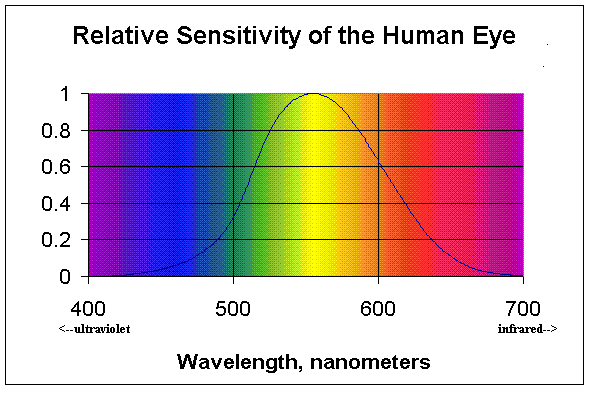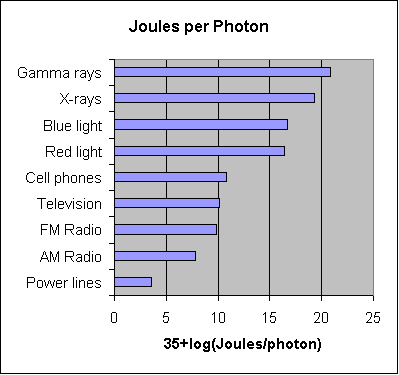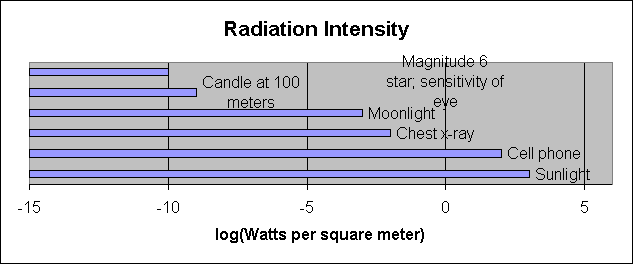| |
Chapter 5: Photons: Cell Phones, Sunlight and X-Rays
Electric power is, without question, one of the greatest
inventions of the human species. Just think: You plug your gizmo into the wall
socket, and out comes all the power you need, for as long as you need it. It’s
cheap, too: An hour’s use of the electric company’s
horse
costs less than a dime, and you don’t have to feed it or clean up afterwards.
Electric power is one of the miracles we take for granted, and we notice it
only when it is taken away, during those rare days of blackouts and violent
storms. Electric power cools and heats your home, washes
and dries your clothes and dishes, fires up your computer and television, and
lights up your nights. It is, as a spokesman for the industry once said,
women’s liberation, although he should have mentioned the birth control pill
in the same breath.
Electric power isn’t entirely safe, of
course. In the United States, about 1000 people die every year from accidental
electrocution. That’s two or three in a million, roughly speaking, a small
enough number that hardly anyone notices, except for the friends and kin of
the deceased.
There are other hazards of living with
electric power. Coal-fired power plants emit acids and particulates (dust),
nuclear plants have radiation dangers, and hydroelectric plants despoil the
landscape. These hazards are harder to quantify, although they are all surely
real, if in some cases perhaps small. We are all guinea pigs in the progress
of technology, although the good news is that, on balance, our life spans keep
increasing, year after year.
One danger of electric power is almost surely not real – the
presumed hazard of living under high voltage power lines, or, for that matter,
sleeping under electric blankets. For a time it was widely
believed that close proximity to electric power lines could cause a variety of
health problems, including childhood leukemia and adult cancer. The belief
originated in a statistical association. After much study, the association
appeared to weaken, and has since been attributed to other causes. Wealthy
neighborhoods can usually fight off having power lines placed locally; poor
neighborhoods are not so successful. Poor people have more health
problems.
More recently, an alarm was sounded over the
use of cell phones. Maybe cell phones cause brain cancer. The alarm didn’t
last very long. I think people found cell phones so convenient they were
willing to ignore any unproved risk. The perceived risk in high-voltage power
lines was economic: Unsightly power lines reduce property values. The
perceived risk of cell phones seems limited to the annoyance of other people’s
use, and the hazards of driving while dialing and talking.
To understand why most scientists think
power lines and cell phones do not pose direct risks of health problems
requires a little background in electromagnetic radiation and quantum
mechanics. All radiation, from radio and television to visible light and
x-rays, consists of particles of energy called photons. All photons move at
the speed of light, but differ in the amount of energy each photon carries.
Radio waves carry the least energy per photon, gamma rays and x-rays carry the
most, and visible light is in between, blue light being more energetic, red
light less so. Photons are absorbed by chemical matter in different ways
depending on their energy: x-rays smash into matter and break chemical bonds,
while radio waves have very mild effects that involve heating up whole
molecules and making them move a little faster. An intense beam of radio waves
cannot break chemical bonds, while even a weak beam of x-rays can. (So can the
ultra-violet portion of sunlight.) This is why nuclear radiation, which
consists of photons (and other particles) even more energetic than x-rays, is
dangerous.
The “flux” of energy radiation can be stated
in a couple of different ways. The common measure is watts per square meter of
surface area (or watts per square centimeter), and a good standard is the
sun’s radiation on the earth, about 1000 watts per square meter, or a tenth of
a watt per square centimeter. This is about the same energy flux your skin
would feel if you held your hand nine centimeters from a 100-watt light bulb.
It’s warm, but safe. The other measure of flux is number of photons per square
meter (or square centimeter) per second. For a standard of 0.1 watts per
square centimeter, this varies enormously depending on whether each photon
carries a lot of energy or a little. For radio and TV and cell phones, there
are a lot more photons in 0.1 watt per square centimeter than in an equal beam
of x-rays, but the x-rays would do serious damage to your hand, while a radio
wave would probably do little more than heat your skin. It’s not the number of
photons that matters most, but the energy per photon.
Living cells and organisms have repair
mechanisms, and it seems likely that the human body can cope with low levels
of nuclear radiation, just as it can cope with mild sunburn. For example,
people who live at high altitudes, such as Colorado, are exposed to far higher
levels of cosmic rays (a kind of super-energetic x-ray) than people who live
at sea level, yet do not have higher cancer rates. It seems that there is a
safe level of exposure to cosmic rays, below which no harm can be seen. On the
other hand, people who spend a lot of time outdoors, exposed to the sun, have
far higher rates of skin cancer. Photons of ultra-violet radiation from the
sun have enough energy to break chemical bonds, cause real damage, and
overwhelm the biological repair systems. When it comes to cell phones and
electromagnetic radiation from power transmission lines and electric blankets,
most scientists assume that it is extremely unlikely that the low energy
photons involved can have any effect at all as long as the overall intensity
of the radiation is below the level where strong heating can occur (as in a
microwave oven). As long as the overall energy level is below that of sunlight
it is difficult to see how such radiation can cause any harm. The photons that
originate in a source like a cell phone are far too weak to break chemical
bonds.
We can imagine some mechanisms by which damage
could be done. After all, a cell phone emits nearly a watt, so parts of your
skin will be exposed to energy levels around 0.1 watt per square centimeter. And
this level is not always safe: Looking at the sun for more than a few seconds
can do permanent damage to your retina. Perhaps cell phone radiation passes
through your skull and is preferentially absorbed by a small section of your
brain, which is then heated and cooked. This is not at first glance an absurdly
silly hypothesis, but there isn’t enough energy emitted from a cell phone to do
much cooking. One can try to invent other mechanisms, but it is hard to overcome
the basic facts that the overall energy level is small and the photon energies
too small to break bonds.
Could scientists be wrong about this? Yes.
But I bet my life they aren't. So have tens of millions of fellow guinea
pigs.
Here’s a much more detailed and technical
way of talking about photons. The energy of a single photon is given by the
formula E = h, where
= c/.
(Energy equals Planck's constant times frequency; frequency equals the speed
of light divided by wavelength). For example, from the second formula we can
calculate that the wavelength of a cell phone operating on the 850-megahertz
band ( = 850,000,000 hertz) is about a foot
(35 centimeters, to be more exact), since the speed of light is 30,000,000,000
centimeters per second. From the first formula, the energy of a single photon
from a cell phone antenna is 5.6 x 10-25 joules. A watt is a joule
per second, so a one-watt phone emits 1.8 x 1024 photons per
second. That's a lot of photons!
For comparison, visible light has wavelengths
around 5 x 10-5 centimeters, so the energy of a single photon is
around 4 x 10-19 joules, far more than a photon from a cell phone.
Correspondingly, the number of photons is much smaller, and our standard solar
flux of 0.1 watt per centimeter squared is equivalent to 2.5 x 1017
photons per square centimeter per second. It is not surprising that looking
directly at the sun can damage your retina given that the eye is able to see
light as dim as a few dozen photons in a short flash. The central part of the
human retina is only 0.01 square centimeters in size (a square millimeter), and
contains about 150,000 cells – about a third as many pixels as your (much
larger!) computer screen. So looking at the sun means that each cell is
receiving billions of photons per second.
Consider, by contrast, the light from a
candle, which emits about 0.0015 watts in the visible part of the spectrum. At
a distance of a meter from the candle, the light intensity is about 1.2 x
10-8 watts per square centimeter. At ten meters, 1.2 x
10-10. At one hundred meters, 1.2 x 10-12 watts per
square centimeter. At this distance you can still see the candle, but your eye
is receiving only three million photons per square centimeter per second.
Since the diameter of your pupil is only about 6 millimeters (dark adapted),
only about a million photons per second enter your eye, which has a focal
length of about 1.7 centimeters, roughly f/3 in camera terms. The image of a
candle one centimeter in diameter at a distance of 100 meters (104
centimeters) has a diameter of only 1.7 x 10-4 centimeters on
your retina, or an area of 2.3 x 10-8 square centimeters. This is
less than the size of a single receptor cell! But your eye, by doing some
clever movements, and some equally clever computing, can still see the candle,
which is, in effect, a point source, like a star in the sky. The eye can see
stars with a magnitude of 6 or less, corresponding to an intensity of about
10-14 watts per square centimeter, or about 10,000 photons per
second on your retina. And you could do even better with a flickering light
source. As the figures below indicate, the eye can deal with an extraordinary
range of intensities although, outside the range 400 to 700 nanometers, it has
no sensitivity at all.

Visual acuity is another matter. The eye can only resolve two
points that are farther apart than about a tenth of the diameter of the moon.
This is equivalent to two objects a centimeter apart a thousand centimeters
away. On your retina, these two points would be 1.7 x 10-3
centimeters apart. A circular spot of this diameter would include about 30
receptor cells. This is why we cannot see the mountains of the moon without a
telescope.
We have seen that the eye can deal with an extraordinary range
of visible electromagnetic radiation, from 10-14 to (perhaps)
10-2 watts per square centimeter. What about x-rays?
X-rays are produced by accelerating electrons in a cathode ray
tube (CRT), in much the same fashion as electrons are accelerated in the tube
of a television set or a computer monitor. The voltages in an x-ray machine
are a little higher, 60,000 volts versus 35,000 in a TV, but of course
consumer CRTs use lead crystal glass to reduce x-ray emissions to a presumably
safe level, while x-ray machines are designed to convert the energy of the
electrons to x-ray photons. Due to losses in the conversion process, the
average energy of an x-ray photon is about 30,000 “electron volts,” which
corresponds to a wavelength of about 4 x 10-9 centimeters.

X-ray wavelengths are extremely short, and are usually measured in Angstroms or
nanometers or picometers. (One Angstrom is a tenth of a nanometer, or
10-8 centimeters. A picometer is 10-12 meters, or
10-10 centimeters.) An x-ray photon with a wavelength of 40
picometers has an energy of 5 x 10-15 joules. A flux of 0.1 watt
per centimeter squared is equivalent to about 2 x 1013 photons per
square centimeter per second. Actual x-ray exposures are far less intense, and
the exposure lasts only a couple of seconds. What matters here is not the
flux, but the total dose. A typical chest x-ray delivers a dose of 0.1 mSv
(milliSieverts), where a
Sievert
is defined as a joule of photon energy absorbed per kilogram of body mass.
Assuming that your chest region weighs about ten kilograms, it absorbs about
0.001 joules of radiation during an x-ray. By way of comparison, a mere
one-second exposure of your chest area (about 1000 square centimeters) to
sunlight would deliver 100 joules. So a chest x-ray doesn’t sound like much
radiation until you recall the difference in energy per photon. A dose of 10
Sieverts can kill you.

To understand what happens when the body is exposed to x-rays,
consider that a ten Sievert dose to your chest area means that your body has
absorbed 2 x 1016 photons, each one of which causes some damage to
a chemical bond in your body. Ten kilograms of your body (which is mostly
water) contains about 1027 atoms. So only five atoms in
1010 are affected – five atoms in ten billion. Not many, surely,
but enough to kill. Yet a dose one hundred thousand times smaller is
presumably
safe. Just why the disruption of only five atoms in ten billion can kill is
not well understood, nor is it clear why smaller doses are safe. Biological
systems have mechanisms for repairing cell damage or destroying damaged cells,
and, presumably, as long as these mechanisms can keep up with the rate of
damage, full and rapid restoration is likely. Once these mechanisms are
overwhelmed, repair is no longer possible. A
cell
contains (very roughly) 1.5 x 1014 atoms, so a ten Sievert chest
dose affects three cells in ten thousand. A dose of 0.1 mSv affects only three
cells in a billion. That seems to be a level of damage your body can cope
with.
What we have shown here is that the risk from radiation has
little to do with overall intensity (as long as the intensity is insufficient
to cook you). What matters is the way radiation and atoms interact. Weak
photons from cell phones are probably harmless; stronger photons from visible
light also cause little harm although the eye can detect amazingly low levels
of energy. But when it comes to the highly energetic photons in x-rays and
cosmic rays, very low doses of energy can destroy cells and kill, although it
is likely that as long as only a small fraction of cells are killed, the body
can cope.
Exercise #1. If cells were uniform spheres, packed
together like oranges in a supermarket, they would occupy 74% of a given
volume, with the rest taken up by intercellular fluid. Since there are
approximately 675 million cells per cubic centimeter, such cells would have a
diameter of 1.28 x 10-3 centimeters. A: Verify this
calculation. B: If cells were uniform cubes, with no intercellular
fluid, show that the length of a side would be 1.14 x 10-3 cm.
C: If a uniform layer of cells had a thickness of just one cell, how
many cells would there be in an area of 0.01 square centimeters? How does this
compare with the density of cells in the central part of the retina? Why are
these cells called rods?
Exercise #2. The average energy of an x-ray photon is
about 30,000 electron-volts (eV), while the energy required to break a typical
chemical bond is only about 3 eV. In principle, there is enough energy in an
x-ray photon to break 10,000 bonds. It is generally believed that the damage
caused when an x-ray photon interacts with a cell is extremely localized,
confined to the immediate vicinity of the collision site, so that the
interaction affects only one (or at most two) cells. This means that a 10
Sievert chest dose affects far more than five atoms in ten billion while still
disrupting three cells in ten thousand. Compare the expected effects of a 10
Sievert dose of x-rays with the same dose of gamma radiation. Which dose
damages more cells?
Exercise #3. In a photoelectric cell, a voltage and
current are produced when the energy per photon of light on the cell is
greater than a critical value. Weaker photons produce no effect, while more
energetic photons produce one electron per photon at the critical voltage.
(This is called the photoelectric effect; it was first explained by Einstein
in 1905.) A modern solar panel consists of 36 silicon photoelectric cells
wired in series, with a total open-circuit voltage of 21 volts, i.e., 0.58
volts per cell. What is the minimum energy per photon required to produce this
voltage? What is the maximum effective wavelength? How goes this compare to
the wavelength of yellow light, 5 x 10-5 cm? How does this affect
the efficiency of a silicon solar cell?
Exercise #4. The pixels in a digital camera are
basically tiny silicon photoelectric cells. Each absorbed photon produces an
electron, and the electrons are stored and later counted to produce an image.
Since each absorbed photon produces only one electron, how is it possible to
produce a colored image?
Exercise #5. The cells in your retina act in a way that
is very similar to the pixels in a digital camera, except that photon
absorption produces a reversible chemical change rather than an emitted
electron. How is it possible for us to see colors?
© 2007 Peter O’Donnell Offenhartz
|
|